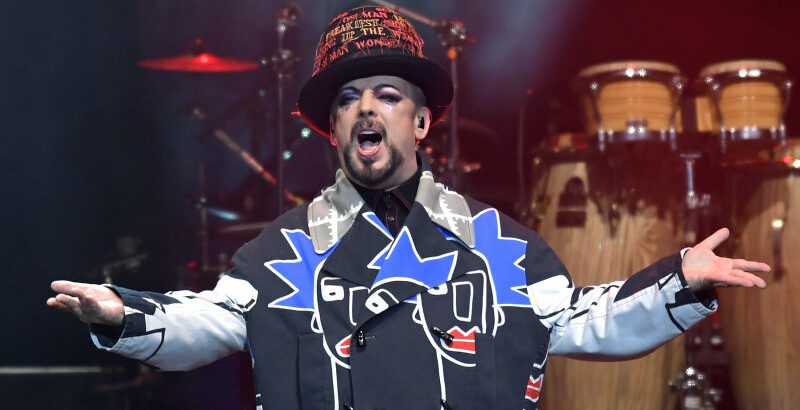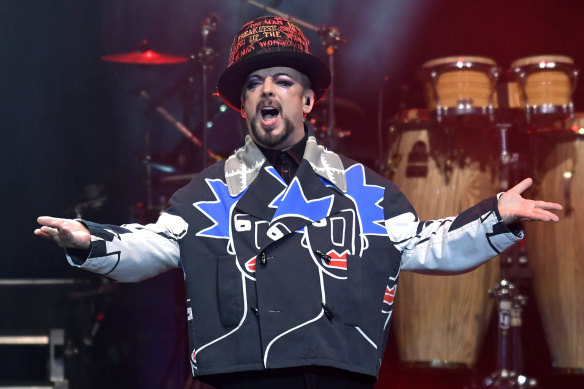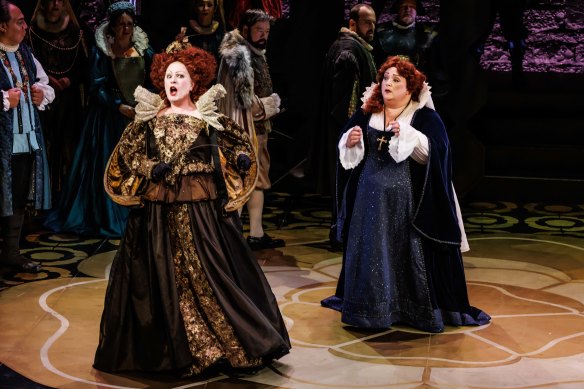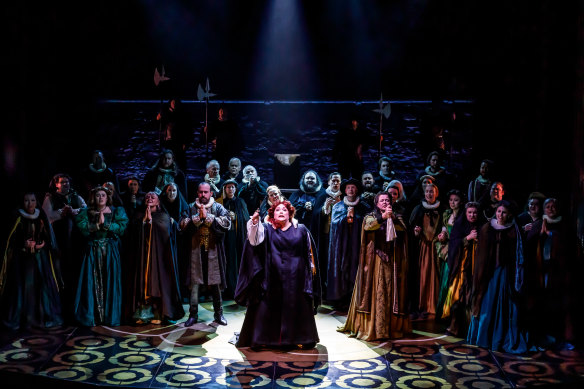Save articles for later
Add articles to your saved list and come back to them any time.
This wrap of shows around Melbourne includes a gig that proves that Culture Club is no simple throwback act, and an opera centring on a fictional royal love triangle.
MUSIC
Culture Club | The Greatest Hits Tour ★★★★
Rod Laver Arena, September 9
You might have thought it didn’t matter that you missed Culture Club’s Greatest Hits tour on Saturday night, but you were wrong – and the packed crowd at Rod Laver Arena knew it.
Iconic synth-rockers Berlin were supporting, blazing through a set of hits culminating in the classic Take My Breath Away, which of course, did. Terri Nunn’s magnificent voice, half sweet, half raspy and full of heart is a definitively ’80s sound, just like Culture Club.
Culture Club’s Boy George performs to a packed Melbourne crowd. Credit: Martin Philbey
Culture Club is no simple throwback act, however. The band’s celebration of diversity of background, sexuality and musical style makes them absolutely contemporary. They were a band uniquely ahead of their time, embracing soul, new-wave, reggae and rock in a glorious synthesis. They did it their way. To quote our maestro, “I’m Boy George and I created myself … from cardboard and glitter.”
Surprisingly, they began with The Rolling Stones’ Sympathy for the Devil, getting fans on their feet from the get-go, followed by classic banger It’s a Miracle. Guitarist Roy Hay urged us to throw our hands in the air, but mine already were.
Culture Club proved they were no simple throwback act in an electric gig at Rod Laver Arena. Credit: Martin Philbey
Boy George is not a wild dancer in the Mick Jagger sense, even though he treats us to a choreographed shuffle in I’ll Tumble 4 Ya; tonight is just about top hits played damn well. As George says, “we specialise in sad songs that put you in a good mood”, and this was in full evidence in Move Away, Miss Me Blind, Time (Clock of the Heart) and the eternally sublime Do You Really Want to Hurt Me.
The northern soul-style stomper Church of the Poison Mind was a particular highlight, incorporating a deviation into Wham’s similarly soul-inspired I’m Your Man in a fitting acknowledgement of that other wonderful ’80s George.
The encore begins with a massively rocking version of T.Rex’s Get It On, after which fans behind me start screaming for Karma Chameleon, which amazed me. Surely they know it’s definitely getting played? Surely they want to look a little cooler and request a song which isn’t the band’s massive monster hit?
But then I realised, Culture Club fans don’t care about looking cool. They want pop and they want it now!
And they get it. Karma Chameleon drives the arena wild, everyone “dances like an idiot” as Boy George had urged us to and then we go out into the cold Melbourne night, marvelling at what joy can be created from cardboard and glitter.
Reviewed by Andrew McClelland
OPERA
Maria Stuarda★★★
Athenaeum Theatre, until September 17
Donizetti wasn’t one to let the truth get in the way of a good story. His operatic telling of the rivalry between Mary Stuart, Queen of Scots and Queen Elizabeth I is the result of a German play, translated into Italian, then written up again by a 17-year-old novice librettist.
As a consequence, Maria Stuarda is a long way from history. But realism is hardly why we go to the opera, right?
Melbourne Opera has revived Suzanne Chaundy’s 2015 production, this time with internationally renowned Australian soprano Helena Dix in the title role.
Eleanor Greenwood and Helena Dix perform as Elisabetta and Maria, two queens who in reality never met. Credit: Robin Halls
The opera centres on two matters of fiction – a love triangle between Mary, Elizabeth and the Earl of Leicester, and a confrontation between the two queens, when in reality they never met.
The imagined clash is perfect opera fodder. Mary yells, “Vil bastarda” at Elizabeth as they spit fiery high notes at each other. It’s great. But on the whole, the opera is uneven. The coup de theatre happens too soon, and with the confrontation scene over we’re left with a long lament for the final act.
The compositional category within which all Donizetti operas fall, bel canto, relies on showstopping singing. If you’re not super into vocal fireworks, bel canto can be a bit boring. Not so with Helena Dix. Everything this style is about – technique, tone, text – Dix has got it. No note too high, no pianissimo too soft. She traverses the literal ups and downs of this extraordinarily demanding repertoire with apparent ease.
Elizabeth here is entirely unsympathetic and her vocal requirements more steely than sweet. Eleanor Greenwood began somewhat uneasily and appeared more comfortable as the night progressed, at her best as she signed Mary’s death warrant. A former mezzo, it’s unsurprising her low notes were tremendous.
Helena Dix rises to every musical challenge this opera throws her way.Credit: Robin Halls
Henry Choo is back as the hapless Leicester after appearing in the 2015 production. He really is superb in this role. His Act I duet with Dix was affecting, their voices complementing each other beautifully.
Unlike for voice, this score doesn’t allow the orchestra much showing-off. Donizetti’s orchestration can wade into oom-pah-pah accompaniment but conductor Raymond Lawrence did a commendable job of keeping things moving. Lawrence’s long history as a chorus master was evident, the Act III choruses were excellent.
Maria Stuarda is a curious programming choice, having been seen recently by regulars, and it could hardly be argued this opera is bringing in a new audience.
What’s unquestionable is Dix’s reign supreme as the queen of beautiful singing.
Reviewed by Bridget Davies
The Booklist is a weekly newsletter for book lovers from books editor Jason Steger. Get it every Friday.
Most Viewed in Culture
From our partners
Source: Read Full Article




